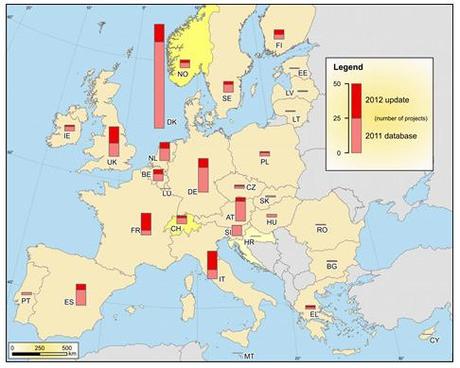The Joint Research Centre (JRC), a Directorate-General of the European Commission that provides independent scientific and technical advice to the European Commission to support a wide range of EU policies has published an update of the 2011 report “Smart Grid projects in Europe: lessons learned and current developments,” which is the most comprehensive inventory of smart grid and smart metering initiatives across the European Union, Croatia, Switzerland and Norway.

Geographical distribution of the number of SG projects surveyed in 2011 inventory and in the 2012 update (Credit: EU, 2012)
The current release of the inventory focuses specifically on the smart grid research, development and demonstration projects. The recent developments and lessons learned from smart metering activities in Europe will be discussed in a dedicated report to be issued by the European Commission still in 2013.
In the 2012 update, 281 smart grid projects were identified, accounting for a total investment of €1.8 billion ($2.35 billion). Project budgets of over €20 million ($26 million) have been growing steadily from 27% in 2006 to 61% in 2012.
The UK, Germany, France and Italy are the leading investors in demonstration projects, while Denmark is most actively involved in R&D. EU-15 organisations are managing the bulk of investment and are also tightly cooperating in multinational projects, of these, 95% are supported by EC funding. Together with national and regulatory funding, they provide 55% of the total budget for the smart grid projects surveyed; the remaining 45% comes from private capital. Utility and energy companies are most involved in smart grid projects, followed by universities and research centers, manufacturers, IT and telecoms businesses, and transmission system operators.
The projects mainly targeted the following applications: control systems to improve the observability (e.g. smart meters to collect and store, on demand and in real time, data for consumers) and the controllability (e.g. frequency and power flow control) of the networks; distributed ICT architectures for coordinating distributed energy resources (e.g. wind farms, photovoltaic plants and co-generation units) and balancing demand and supply in a flexible way; charging and communication infrastructure works for electric vehicles; and use of storage as an additional source of grid flexibility. The main barriers for smart grid projects are a lack of interoperability and standards, regulatory barriers and consumer resistance to participating in trials.

